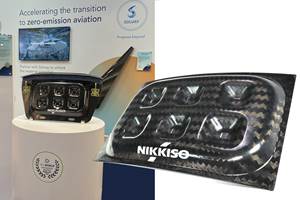Thermwood and Bell collaborate on 3D-printed helicopter blade mold
Thermwood employed its new 60-mm melt core technology to additively manufacture the autoclave-capable, carbon fiber-reinforced tool.
Long-lead-time tooling is a common limiting factor in aerospace development. A joint venture program between Bell (Fort Worth, Texas, U.S.) and Thermwood Corp. (Dale, Ind., U.S.) recently explored a solution, resulting in what Thermwood claims may be “the largest 3D printed autoclave-capable tool ever made.”
Bell enlisted Thermwood to print a closed-cavity helicopter blade mold measuring approximately 20 feet long, 14 inches wide and 17 inches high. The tooling was required to meet several requirements: It must be printed in one continuous run for vacuum integrity, its surface finish must be 32 RMS or better and it must be able to withstand 90 psi at 360°F. Tight tolerances were also required to ensure proper mating of the two blade mold halves.
Thermwood employed its new 60-mm melt core technology, which was recently installed on the company’s Large Scale Additive Manufacturing (LSAM) system at its Development/Demonstration Lab in Southern Indiana. The standard LSAM machine print head housing can be equipped with different capacity melt cores, each offering different minimum and maximum throughputs. According to Thermwood, the new 60-mm melt core has a measured maximum output of 480-570 pounds per hour, depending on the polymer being printed, and can print more than 100 feet of typical print bead (.830" x .200") per minute. This high print rate, even when processing high-temperature material, is said to allow the print bead to be oriented along the length of the tool.
During Thermwood’s room-temperature print process, the cycle time for each layer is determined by how long it takes the printed polymer to cool to the proper temperature to accept the next layer. According to Thermwood, only by printing at the proper temperature is it possible to achieve a completely fused, void-free structure capable of maintaining a vacuum in an autoclave without a coating. The print head output determines how much material can be printed during the time it takes for the layer to cool. As the company explains, “bigger print heads mean larger parts, not necessarily faster layer to layer print time.”
Thermwood printed Bell’s tool in one continuous run using Techmer PM’s (Clinton, Tenn., U.S.) 25 percent carbon fiber-reinforced PESU (Polyethersulfone), a material specifically formulated for LSAM additive printing. The material has a glass transition temperature (Tg) of more than 400°F and reportedly can survive common aerospace component cure cycles. Thermwood technicians claim Techmer PESU prints as easily as ABS, but at a much higher temperature.
The resulting print time for one tool half was 3 hours 8 minutes. The part had an “as printed” weight of 542 pounds.
The internal printed structure of the tool supports the mold without touching the back side of the mold cavity, allowing air to flow freely under the entire formed part in the autoclave – which helps the part cure more consistently. According to Thermwood, the ability to incorporate a complex internal design is another advantage of using additive manufacturing for this type of tooling, and its LSAM Print 3D slicing software is designed to support programming of involved internal structures such as these.
In addition to printing, the LSAM is capable of supporting trim and drill processes. Once the tool half was printed, Thermwood machined it within 40 hours. Further, the completed bond tool was able to maintain Bell’s vacuum standards required for autoclave processing right from the machine, without the need for a seal coating.
“This is a game changer,” says James Cordell, manager of Manufacturing Innovation at Bell. “Being able to print, machine and utilize tooling in weeks in lieu of months will revolutionize the way we look at tooling going forward.”
Soon Thermwood will print the second half of the blade mold, with the goal of having Bell cure a full molded blade within the final additively-manufactured bond tool. The two companies plan to conduct further testing on PESU printed molds.
Related Content
Dawn Aerospace reusable rocket-powered aircraft flies twice in one day
Eighth and ninth flights of composites-intensive Mk-II Aurora reach an altitude of 63,000 feet, demonstrates same-day reusability capability for rocket-powered systems.
Read MoreInfinite Composites: Type V tanks for space, hydrogen, automotive and more
After a decade of proving its linerless, weight-saving composite tanks with NASA and more than 30 aerospace companies, this CryoSphere pioneer is scaling for growth in commercial space and sustainable transportation on Earth.
Read MoreJEC World 2023 highlights: Innovative prepregs, bio-resins, automation, business development
CW’s Jeff Sloan checks in with JEC innovations from Solvay, A&P, Nikkiso, Voith, Hexcel, KraussMaffei, FILL, Web Industries, Sicomin, Bakelite Synthetics, Westlake Epoxy and Reliance Industries.
Read MoreRocket Lab begins installation of large AFP machine for rocket production
The 99-ton AFP machine, custom-designed and built by Electroimpact, is claimed to be the largest of its kind, expecting to save around 150,000 manufacturing hours in the Neutron rocket’s production process.
Read MoreRead Next
Developing bonded composite repair for ships, offshore units
Bureau Veritas and industry partners issue guidelines and pave the way for certification via StrengthBond Offshore project.
Read MoreAll-recycled, needle-punched nonwoven CFRP slashes carbon footprint of Formula 2 seat
Dallara and Tenowo collaborate to produce a race-ready Formula 2 seat using recycled carbon fiber, reducing CO2 emissions by 97.5% compared to virgin materials.
Read More“Structured air” TPS safeguards composite structures
Powered by an 85% air/15% pure polyimide aerogel, Blueshift’s novel material system protects structures during transient thermal events from -200°C to beyond 2400°C for rockets, battery boxes and more.
Read More













.jpg;maxWidth=300;quality=90)








